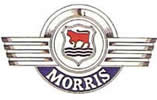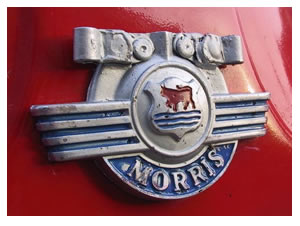 |
 All Classic Ads Vintage Collection - Morris related ads All Classic Ads Vintage Collection - Morris related ads
Ad • Ad
 History of Morris Motor Company(1910) History of Morris Motor Company(1910)
The Morris Motor Company was started in 1910 when bicycle manufacturer William Morris turned his attention to car manufacturing and began to plan a new light car. A factory was opened in 1913 in a former military college at Cowley, Oxford, United Kingdom, and the company's first car, the 2-seat Morris Oxford "Bullnose" was introduced.
Nearly all the major components were bought-in, with only final assembly being undertaken in the Morris works. In 1914 a coupé and van were added to the line-up but the chassis was too short and the 1018 cc engine too small to make a much-needed 4-seat version of the car.
|
|
 White and Poppe, who made the engine, wanted more money than Morris was prepared to pay for a larger version, so the company turned to Continental of Detroit, Michigan, United States for supplies of a 1548 cc unit. Gearboxes and axles were also sourced in the US. In spite of the outbreak of the First World War the orders were maintained and, from mid-1915 a new larger car, the 2-seat and 4-seat Morris Cowley was introduced. White and Poppe, who made the engine, wanted more money than Morris was prepared to pay for a larger version, so the company turned to Continental of Detroit, Michigan, United States for supplies of a 1548 cc unit. Gearboxes and axles were also sourced in the US. In spite of the outbreak of the First World War the orders were maintained and, from mid-1915 a new larger car, the 2-seat and 4-seat Morris Cowley was introduced.
After the war the Continental engine was no longer available, so Morris arranged for the French company Hotchkiss to make a near-copy in their Coventry factory. This was used to power new versions of the basic Cowley and more up-market Morris Oxford cars. With a reputation for producing high-quality cars and a policy of cutting prices, Morris Motor Company continued to grow and increase its share of the British market and, in 1924, overtook Ford to become the UK's biggest car manufacturer, holding a 51% share of the home market. They had a policy of buying up suppliers with, for example, Hotchkiss in Coventry becoming the Morris Engines branch in 1923. In 1924 the head of the Morris sales agency in Oxford, Cecil Kimber, started building sporting versions of Morris cars, called "MG" — after the agency, Morris Garages. The MG factory was in Abingdon, Oxfordshire.
The small car market was entered in 1928, with the Morris Minor, using an 847 cc engine from the Wolseley Motor Company, a company which became part of Morris Motors Company in 1927. This helped the company through the economic depression of the time. The Minor was replaced at the 1934 London Motor Show by the Morris Eight, a direct response to the Ford Model Y and heavily based on it. In 1932 Morris appointed Leonard Lord as Managing Director and he swept through the works, updating the production methods and introducing a proper moving assembly line, but Morris and Lord fell out, and Lord left in 1936 — threatening to "take Cowley apart brick by brick". Also in 1936 William Morris sold Morris Commercial Cars Limited, his commercial vehicle enterprise, to Morris Motors. In 1938 William Morris became Viscount Nuffield, and the same year he merged the Morris Motor Company (incorporating Wolseley) and MG with newly acquired Riley to form a new company: the Nuffield Organisation.
In the summer of 1938 the Nuffield Organisation agreed to build equip and manage a huge new factory at Castle Bromwich, which was built specifically to manufacture Supermarine Spitfires.
Production restarted after World War II, with the pre-war Eight and Ten designs. In 1948 the "Eight" was replaced by what is probably the most famous Morris car, the Morris Minor designed by Alec Issigonis (who later went on to design the Mini) and reusing the small car name from 1928. The "Ten" was replaced by a new 1948 Morris Oxford, styled like a larger version of the Minor. A later Morris Oxford (the 1956 Morris Oxford III) was the basis for the design of India's famous Hindustan Ambassador which continues in production to the present day.
In 1952, the Nuffield Organisation merged with its old rival the Austin Motor Company to form the British Motor Corporation (BMC). Nuffield brought the Morris, MG, Riley and Wolseley marques into the merger. Leonard Lord was in charge, which led to Austin's domination of the organisation. Badge-engineering was important to the new company and for many years the several marques would be seen on several families of similar vehicles.
In 1968, in further rationalisations of the British motor industry, BMC became part of the newly-formed British Leyland Motor Corporation (BLMC), and subsequently, in 1975, the nationalised British Leyland Limited.
The Morris marque continued to be used until the early 1980s on cars such as the Morris Marina. The Morris Ital (essentially a facelifted Marina) was the last Morris-badged passenger car, with production ending in the summer of 1984. The last Morris of all was a van variant of the Austin Metro.
In the early 1980s, the former Morris assembly plant in Cowley was turned over to the production of Austin and Rover badged vehicles, and continued to be used by BL's Austin Rover Group and its successor the Rover Group, which was eventually bought by BMW, and then by a management consortium, leading to the creation of MG Rover.
The rights to the Morris marque are currently owned by MG Rover, but after that company's financial collapse, and partial purchase by one or more Chinese state businesses, it is not clear who will finally own the Morris marque. Neither of the Morris Assembly Plants now exist, they were demolished and replaced by a technology park, the adjacent Pressed Steel Compnay site ( Cowley Body Plant ) is owned and operated by BMW, who use it to assemble the new Mini. MINI.
The history of the company is commemorated in the Morris Motors Museum at the Oxford Bus Museum.
Post-Morris cars to have been built at Cowley include the Austin/MG Maestro, Austin/MG Montego, Rover 600, Rover 800 and (for a short time) the Rover 75.
Morris 1100/1300 - 1962

With the Mini enjoying incredible sales success thanks to its clever use of interior packaging and fine handling, BMC decided to enlarge the concept with the wheel-at-each-corner 1100/1300 range. The Morris 1100 debuted in 1962 and looked modern, with clean lines and surprisingly entertaining driving characteristics. It featured a transversely-mounted A-Series engine and four-speed gearbox-in-sump transmission to keep production costs to a minimum and maximize interior space, although access to the boot was hampered by a narrow loading aperture. Thanks to BMC policy of 'badge-engineering', the Morris 1100 and 1300 were also sold as Austins, MGs, Wolseleys, Rileys and Vanden Plas versions. It was replaced by the Austin-only Allegro in 1973 - a retrograde step, as its replacement was an inferior car.
Available Morris ads by date and category
1900 - 1919 |
1940 - 1949 |
1970 - 1979 |
|
|
|
1920 - 1929 |
1950 - 1959 |
1980 - 1989 |
|
|
|
1930 - 1939 |
1960 - 1969 |
1990 - 1999 |
|
|
|
 |
Size - A
Grading - B
Availability - C
Price - $
Shipping and handling - verify postal code
|
 |
Size - A
Grading - B
Availability - C
Price - $
Shipping and handling - verify postal code
|
|
|



